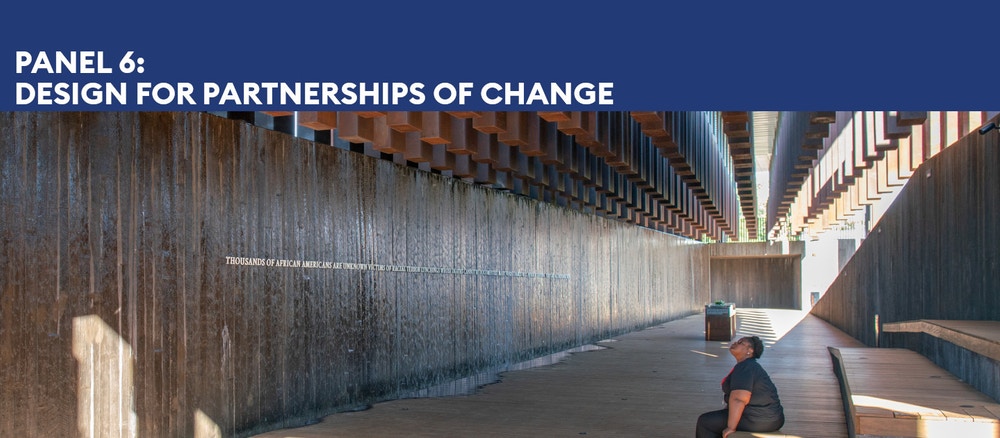PANEL 6
Panel Chairs: Sandi Hilal and Merve Bedir
Architects must foster partnerships, and work across many different professions and skills to create a sustainable and inclusive future. The work needed for a sustainable world requires the participation of a vast multitude of actors, both public and private, from many different sectors, skills and educations.
Design for PARTNERSHIPS FOR CHANGE
This panel emphasizes the inadequacy of existing definitions, partnerships, and methods on “sustainability” and “development,” but also the necessity of “leaving no one behind.”
Design for Partnerships is about recognizing the asymmetrical relationships between states, public spaces, civil societies and private domains, and finding a new balance for the existing power structures. This panel aims to build alliances to challenge dominant structures and redistribute power relations to seek social and environmental justice, and access to rights for all. Challenging the ontology of universalism, Design for Partnerships examines how to rethink architecture and the built environment to play an essential role in its ability to create the ground for care, local governance, space making practices, imaginaries and scenarios of plural(istic) political, socially and ecologically sustainable futures.
This panel intends to acknowledge unrecognized practices by bringing back everyday-life experiences, different paths and forms of knowledge production and storytelling that inform our understanding of design today. The call is an effort to re-frame main spatial concepts such as design, communities, commons, and participation, among others, and thus call for new partnerships, as an active way to rethink and transform the disciplinary and discursive practice of architecture.
Design for Partnerships for Change asks for papers that engage with these perspectives and critically explore how architecture can understand, build and fulfill its active role in achieving the UN Sustainable Development Goals (SDGs).
SUB-QUESTIONS FOR DESIGN FOR PARTNERSHIPS FOR CHANGE
6.1 RE-FRAMING COMMUNITY
How to reframe the understanding of communities beyond who is the care-giver and who is care-receiver, who is the guest and who is the host, who is the saviour and who needs to be saved today?
How to re-frame the understanding of the concept of ‘communities’ in their role of political subjects able to create alliances and contribute actively in more inclusive and open collective domains?
6.2 RE-FRAMING PARTICIPATION
How to understand participation beyond the asymmetrical relationship between “organizers” and the participating communities that are often reduced to “relief recipients”, who should gratefully endorse the attempt of those who are there to help them?
How to re-frame participation not only as a performative tool that makes organisers feel good but in its ability to challenge dominant power structures and to find new balances between existing structures and how not to hesitate to understand participation as a tool of operation to negotiate conflict?
6.3 RE-FRAMING COMMONS
The modernist assumptions of public space and natural habitat is about their design and management that eventually allow them to exist without people and communities. The ethics of commons and commoning dismantle this assumption.
How to re-frame the understanding of the commons as spaces near and far, created by the interaction of people, where commons can exist only if people and more-than-human agencies of habitat are constantly producing them?
6.4 RE-FRAMING DESIGN
The discursive and disciplinary aspects of design sustain a dominance of a unique modernist universalism through the skills acquired at school and the knowledge produced in academia, which fail to respond to the needs and desires across particular situations. The references of expertise that inform the roles of designers within the communities and environments diminish the potential and impact of design both as intervention and as critical imagination.
How to re-frame design in its role of challenging dominant structures by strengthening and amplifying alliance building and people-centered space making? How to set the architectural language free from a unique universalism, towards a language of plurality?
6.5 RE-FRAMING AGENCY
The decision-making power and the proximities that different roles, people, and communities have amongst each other, the ways and dynamics of negotiation within and across communities relate to the degrees of autonomy, collectivity and representation of agencies. How to link and design agency in the absence of the state? How to re-frame agency when aiming for design for change, and design for partnerships? What are the potentials of designers’ agency?
6.6 RE-THINKING LAND
The relationship of people with land, soil, technologies, and environment needs to be re-thought, and land needs to be considered as a totality of the ground including what is stood on, what is below as well as above. Who are those that look after land? What are the ways of maintaining, managing, and caring for land as a space of connecting and sharing? What are the ways of owning and belonging? How to expand this re-framing to practices of degrowth and healthy growth? What are the meanings of infrastructure as the physical and ephemeral glue of land? How to think of the alliances needed for just transitions of land?
VISIT THE SIX PANELS
Panel 1
Design for Climate Adaptation
Architecture faces a grave challenge in a world struck by climate change. The built environment must adapt to changing weather patterns, higher temperatures and flooding.
Panel 2
Design for Rethinking Resources
Resources are getting scarcer, and architects need to address this issue. By using novel materials and recycling on a much greater scale, architecture can change its approach to resources..
Panel 3
Design for Resilient Communities
Communities are people, and people create communities. Architects can positively impact the lives of millions, even billions, by building for the future, and creating communities that last.
Panel 4
Design for Health
Healthy living takes place in healthy environments, and architects can help improve public health through careful planning, building and consideration.
Panel 5
Design for Inclusivity
A sustainable world is one with room and consideration for all people. Architects must design with inclusivity in mind, and take care to understand the needs of the many different people that inhabit the globe.


